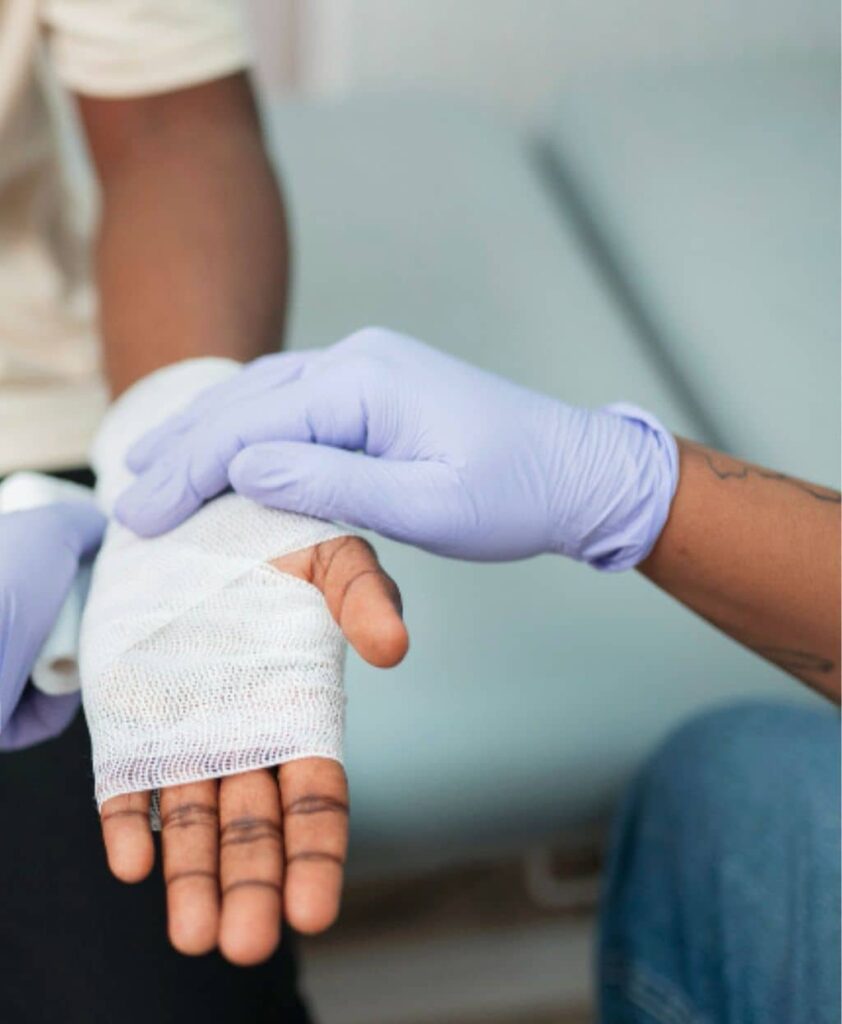Cast Care and Major Dressing services at Dynasty Clinic focus on proper wound management and cast maintenance to promote faster healing and prevent complications.

Cast Care and Major Dressing services at Dynasty Clinic focus on proper wound management and cast maintenance to promote faster healing and prevent complications.
Dynasty Clinic provides professional Cast Care and Major Dressing services to ensure safe and effective recovery after injuries or surgeries. Whether you have a fracture requiring a cast or wounds that need large dressings, our medical team focuses on proper hygiene, comfort, and protection. This service helps prevent infections, reduces swelling, and supports proper healing of bones and soft tissues. Our experts carefully assess your condition, guide you through cast maintenance, and offer timely dressing changes for optimal results. With personalized care and attention, we make your healing journey faster, safer, and more comfortable.
Cast Care and Major Dressing refer to medical procedures aimed at protecting and managing injuries during the recovery process. Cast care ensures that fractures heal correctly by maintaining proper immobilization and keeping the cast clean and dry. Major dressing involves the professional application and monitoring of large wound bandages to prevent infection and promote healthy tissue regeneration. At Dynasty Clinic, we provide expert supervision, ensuring that every step of your care meets the highest medical standards for comfort and safety. Our team also guides you on how to maintain hygiene between visits and when to report any unusual symptoms. We aim to make your recovery experience smooth, supportive, and effective.
The process begins with a thorough examination of the injured area to evaluate healing progress and identify any signs of discomfort or infection. Our specialists clean and disinfect the wound, apply or adjust dressings, and ensure casts are properly fitted without causing pressure or irritation. For cast care, we educate patients on keeping the area dry and protected, while for major dressing, we use sterile techniques and advanced materials to support recovery. This consistent care helps prevent complications and ensures quicker healing under expert supervision. Our staff also checks for circulation issues or tightness around the cast to avoid potential damage. We make sure your recovery continues safely and steadily throughout every stage.

Cast Care and Major Dressing are essential for anyone recovering from fractures or wounds needing special attention. If you are experiencing discomfort, tightness, or irritation around your cast or bandage, our medical experts at Dynasty Clinic can help. We assess your condition, ensure proper wound management, and provide guidance for home care. Our Post Operative Care services further support your recovery by monitoring healing, managing dressings, and addressing any complications. Our team is dedicated to helping you heal efficiently and safely through specialized, hands-on medical care.
Some benefits of cast care and major dressing treatments:
This service should be avoided without professional consultation if there are open wounds showing signs of infection, excessive bleeding, or allergic reactions to dressing materials. Individuals should not attempt to change their casts or major dressings at home without guidance, as it may lead to improper healing or complications.
With consistent cast and dressing management, patients experience reduced pain, proper wound healing, and improved comfort. The treatment helps prevent complications and enhances recovery speed, ensuring bones and tissues heal in their correct position. Regular monitoring and care lead to a smoother, more efficient healing process.
Each session typically takes 30 to 60 minutes depending on the type of injury and required dressing. The frequency of visits is determined by your doctor based on the progress of healing and specific care needs. Additional sessions may be scheduled for complex injuries to ensure proper healing.
Recovery duration varies with the injury type. Minor wounds may heal in a few weeks, while bone fractures or surgical wounds can take several months. Consistent care and follow up visits significantly improve healing time and comfort.
At Dynasty Clinic, we combine advanced medical techniques with compassionate care to ensure your recovery is smooth and safe. Our skilled professionals specialize in managing casts and large wound dressings with precision and care, preventing complications and enhancing comfort. We focus on personalized follow up, hygiene, and healing support to help you regain mobility and confidence. With our patient centered approach, we make every step of your recovery stress free and effective.
For more information or to schedule your cast or dressing care appointment, contact us today. Let our experienced medical team at Dynasty Clinic support your recovery with expert care and attention.
More than 250 five-star reviews on Google

Trustindex verifies that the original source of the review is Google. Best clinic in DubaiPosted onTrustindex verifies that the original source of the review is Google. Highly recommend ❤️❤️amazing clinic and staffPosted onTrustindex verifies that the original source of the review is Google. The staff is very professional and the doctors are excellent. Not commercial.Posted onTrustindex verifies that the original source of the review is Google. Best clinic in Dubai, I felt well taken care of from first step Highly recommended 👌Posted onTrustindex verifies that the original source of the review is Google. Amazing clinic with professional caring team Clean , modern and very organized highly recommended ♥️Posted onTrustindex verifies that the original source of the review is Google. دكتوره سيما وايد شاطره وأيدها خفيفه 💖💖💖💖💖💖💖Posted onTrustindex verifies that the original source of the review is Google. Dr. Seema is truly exceptional in her field. Anatomically, she has this remarkable ability to pinpoint exactly where to go and what steps to take, guiding anyone through the intricacies of the human body with ease. When it comes to skin, she can describe not just the surface but the dimensions and texture in a way that makes everything clear. Her depth of understanding and the sheer amount of knowledge she brings to the table really make her a pioneer in her specialty.
You should always keep your cast clean and dry to avoid infection or irritation. Avoid inserting any objects inside the cast to scratch the skin, as it may cause injury. If your cast becomes wet or starts to smell, contact Dynasty Clinic immediately for professional care.
Tightness or pain can indicate swelling or pressure beneath the cast, which requires prompt attention. Do not attempt to loosen or cut the cast yourself. Visit Dynasty Clinic so our specialists can safely assess and adjust it to relieve discomfort.
The frequency of dressing changes depends on the type of wound and how quickly it heals. In most cases, our doctors recommend changing large dressings every one to three days to maintain hygiene. Dynasty Clinic ensures every dressing change is done using sterile materials and precise techniques.
It is best to avoid exposing your cast or dressing to water, as moisture can damage it and slow healing. You may use waterproof covers or protective wraps, but only with your doctor’s advice. Dynasty Clinic provides guidance on how to safely maintain personal hygiene during your recovery.